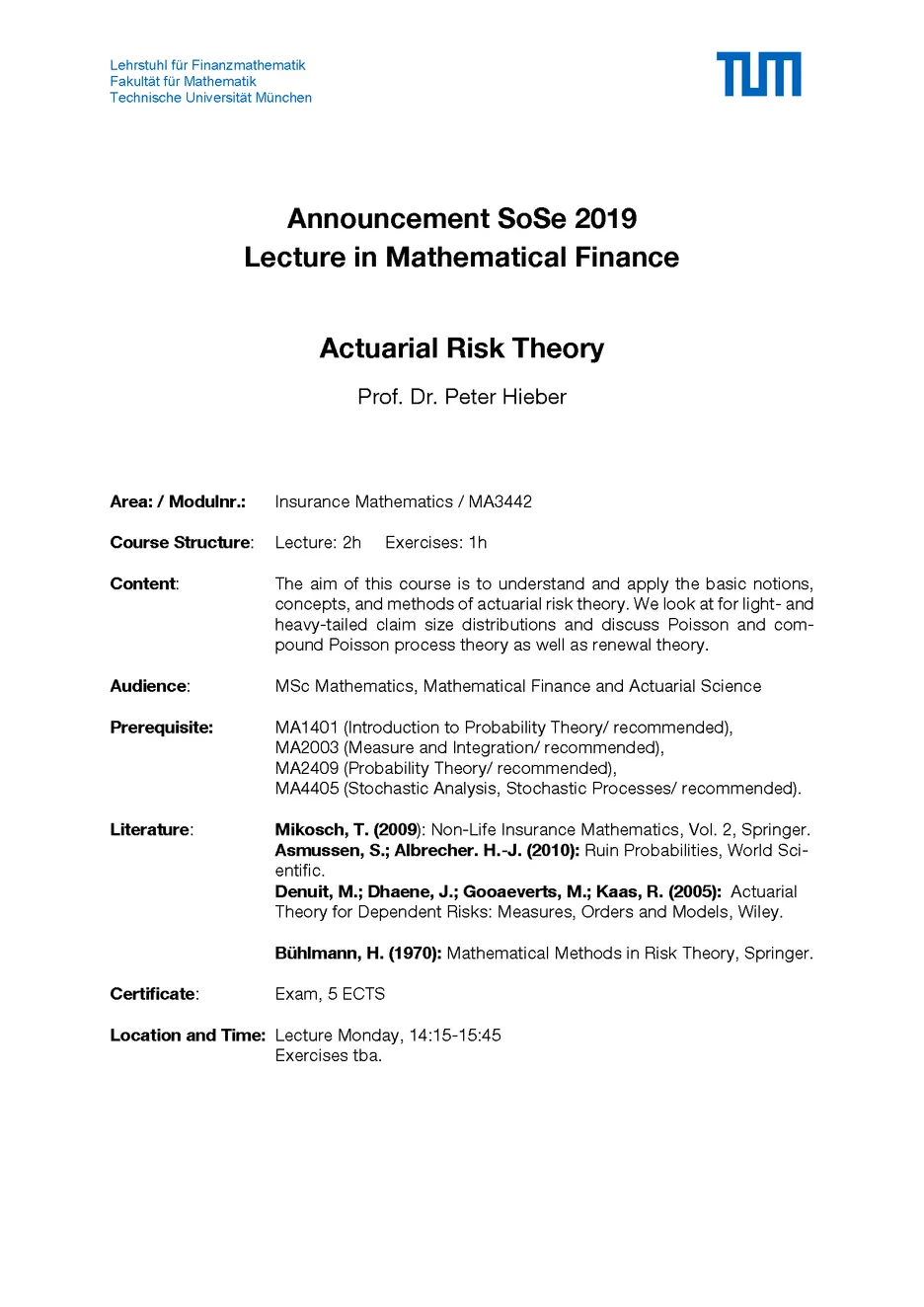Actuarial Risk Theory

Actuarial Risk Theory [MA3442]
| Vortragende/r (Mitwirkende/r) | |
|---|---|
| Nummer | 820915854 |
| Art | Vorlesung |
| Umfang | 2 SWS |
| Semester | Sommersemester 2019 |
| Unterrichtssprache | Englisch |
| Stellung in Studienplänen | Siehe TUMonline |
| Termine | Siehe TUMonline |
Termine
- 29.04.2019 14:15-15:45 BC2 3.1.08, Hörsaal
- 06.05.2019 14:15-15:45 BC2 3.1.08, Hörsaal
- 13.05.2019 14:15-15:45 BC2 3.1.08, Hörsaal
- 20.05.2019 14:15-15:45 BC2 3.1.08, Hörsaal
- 27.05.2019 14:15-15:45 BC2 3.1.08, Hörsaal
- 03.06.2019 14:15-15:45 BC2 3.1.08, Hörsaal
- 17.06.2019 14:15-15:45 BC2 3.1.08, Hörsaal
- 24.06.2019 14:15-15:45 BC2 3.1.08, Hörsaal
- 01.07.2019 14:15-15:45 BC2 3.1.08, Hörsaal
- 08.07.2019 14:15-15:45 BC2 3.1.08, Hörsaal
- 15.07.2019 14:15-15:45 BC2 3.1.08, Hörsaal
- 22.07.2019 14:15-15:45 BC2 3.1.08, Hörsaal
Teilnahmekriterien
Lernziele
After successful completion of the module, students understand standard stochastic models of insurance mathematics which play a role in the risk modelling of insurance companies.
Beschreibung
Actuarial Risk Theory focusses on stochastic risk modelling and risk assessment for non-life insurance. The most important stochastic process in this field is a compound Poisson process, which models the claim arrivals by a Poisson process and the claim sizes by iid random variables. Actuarial risk is measured by the ruin probability and other stochastic quantities describing the ruin event. The ruin probability can be described by the Pollaczek-Khintchine formula, whose asymptotic behavior is found by methods from renewal theory and martingale theory. There is a qualitative and quantitative difference between the small claims case and the large claims case.
Extensions of the model, which may be discussed, include non-homogenous Poisson arrival processes, or a portfolio of risk processes and dependence modeling, or so-called integrated risk processes with investment of the capital reserve.
Extensions of the model, which may be discussed, include non-homogenous Poisson arrival processes, or a portfolio of risk processes and dependence modeling, or so-called integrated risk processes with investment of the capital reserve.
Inhaltliche Voraussetzungen
MA1401 Introduction to Probability Theory, MA2402 Basic Statistics, MA2408 oder MA2409 Probability Theory, MA3401 Stochastic Processes oder MA4405 Stochastic Analysis
Empfohlene Literatur
[1] Asmussen, S. (2000) Ruin Probabilities. Word Scientific, Singapur.
[2] Bühlmann, H. (2007) Mathematical Methods in Risk Theory. 2nd ed. Springer, Berlin.
[3] Denuit, M. (2005) Actuarial theory for dependent risks. Wiley, Chichester.
[4] Embrechts, P., Klüppelberg, C., and Mikosch, T. (1997) Modelling Extremal Events for Insurance and Finance. Springer, Berlin.
[5] Gray, R.J. and Pitts, S.M.(2012) Risk modelling in general insurance. Cambridge Univ. Press, Cambridge.
[6] Mikosch, T. (2003) Non-Life Insurance Mathematics. Springer, Berlin.
[7] Resnick, S.I. (2002) Adventures in Stochastic Processes. 3rd ed. Birkhäuser, Boston.
[2] Bühlmann, H. (2007) Mathematical Methods in Risk Theory. 2nd ed. Springer, Berlin.
[3] Denuit, M. (2005) Actuarial theory for dependent risks. Wiley, Chichester.
[4] Embrechts, P., Klüppelberg, C., and Mikosch, T. (1997) Modelling Extremal Events for Insurance and Finance. Springer, Berlin.
[5] Gray, R.J. and Pitts, S.M.(2012) Risk modelling in general insurance. Cambridge Univ. Press, Cambridge.
[6] Mikosch, T. (2003) Non-Life Insurance Mathematics. Springer, Berlin.
[7] Resnick, S.I. (2002) Adventures in Stochastic Processes. 3rd ed. Birkhäuser, Boston.